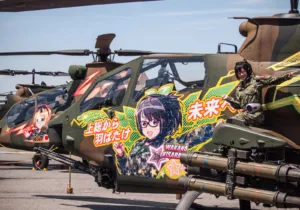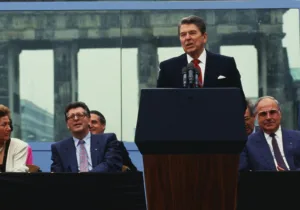Matthew Continetti is on the money when he argues that today’s global tide of violence is, in a way, all part of the same broader assault on the Western rules-based order. The attacks on Ukraine and Israel are part of the same “vast international effort.” “The rabid dogs,” he notes, “are Russia, Iran, and North Korea. Holding the leash is Communist China.”
Though thorough, Continetti’s article mentions only a few of the connections between those four states and two wars; many more examples could be cited. As John Hardie explains, Moscow is collaborating with Hezbollah, such as Russia’s Wagner Group likely transferring a Russian-made Pantsir-S1 air defense system to the Islamist organization. Meanwhile, the Ukrainian people have shown a level of sympathy for Israel unmatched in many Western countries.
A global struggle is unfolding between the free world and the Chinese-led counter-Western alliance, including larger nations like Russia and Iran as well as smaller ones like North Korea and Syria. Despite the seeming formidableness of this authoritarian league, this struggle looks very winnable for the free world. All of the hostile powers appear fragile and, if one of them were to collapse, the others would be further weakened.
Iran
While the attacks of September 11th, 2001, inflected US foreign-policy thought towards greater emphasis on non-state actors, today we are reverting to regular old state-versus-state conflicts. There must be a keener awareness of the continued centrality of states, which are the main pillars of non-state terrorism. “Without Pakistani support,” Michael Rubin avers, “the Taliban would be nothing.” Iran is, if anything, an even more prominent sponsor of terrorism than Pakistan. Iran’s proxies, according to Danielle Pletka, include “Hezbollah, Hamas, Palestinian Islamic Jihad, the Houthis, Iraq’s Popular Mobilization Units, the Assad Regime, and too many others live on Iranian largesse and support.” This complex of problems, notes Pletka, would be greatly alleviated by a fall of the Iranian government.
Such a fall is not unrealistic, and would be far more probable with a different strategy by the US government. As successes achieved under the last administration underscore, it is misguided policymaking rather than a lack of means that keeps the United States from dealing more damage to the clerical dictatorship. Powerful social trends within Iran push for the regime’s collapse, and they will not vanish anytime soon. A 2020 survey suggests that only four in 10 Iranians consider themselves Muslim, with adherence to religious rituals having declined immensely since the Islamic Revolution.
In the big picture of history, it seems a bit of an aberration that Iran ever became a Muslim country at all. More than any other nation in the area, if not the whole Islamic world, Persia had possessed a glorious record of statehood long before Islam. The political underdevelopment of most populations that accepted Islam partly explains the notorious weakness of the nation-state in the Islamic sphere. “For Islam,” as Steven Grosby remarks, “there is an overt opposition to recognizing as legitimate these [national] attachments.” This is another pattern Iran breaks. In an effort to qualify his verdict, Grosby scrapes together a few examples of nationalism from Islamic history, and the only impressive ones come from Persia. Even “Iran’s adoption, under the Safawids, of Shi’ism [occurred] in opposition to the Ottoman Empire’s Sunni beliefs.” The country’s deep national identity is an abiding challenge to so anti-national a creed as Islamism. “[R]egime officials,” wrote Anya Caraiani for the Institute for the Study of War this March, “may assess that historical Persian nationalism still poses a major ideological threat to the regime.”
In addition to depriving religious terrorism of its main support, the Iranian regime’s collapse could prompt a broader abandonment of theocracy in the Islamic world. Iran’s Islamic Revolution was the founding event of the Islamist wave which continues to this day, much as the Russian Revolution – a similarly mythologized event – kicked off the global communist movement. When the Soviet Union disintegrated, the disillusionment with its ideology was ubiquitous. As David Priestland has written, “the world seemed to lose interest in Communism.” Perhaps a similar shift away from Islamism will follow Iran’s democratization.
Russia
Russia’s position in Ukraine is perilous as well. This is reflected in a gloomy assessment by Igor Girkin, a respected Russian nationalist, military commentator, and luminary of Putin’s intellectual circles. Girkin apparently wrote on October 26th that the Ukrainians could soon “be successful in breaking Russian forces […] exhausted by months of combat” and that “Russia has exhausted [its] recruitment potential” barring another mobilization.
On the Ukrainian side, Ukraine’s top military commander Valerii Zaluzhnyi set off a flurry of alarmist reporting when he stated in an interview that the war had reached a “stalemate.” That is not quite what he said, but even if one accepts the simplification, the general stressed that the situation resulted from “parity” with Russia. Considering the baked-in advantages that Russia has enjoyed since the start of the war, it is already an immense achievement to have brought Ukraine onto an equal footing with its numerically superior enemy. And, if Ukraine has already gone from being outmatched to achieving parity, there is no obvious reason why its capabilities cannot be boosted further.
Zaluzhnyi did not just note the problem, but identified perfectly feasible measures to solve it, like expanding Ukraine’s drone arsenal. Days later, it was reported that Ukroboronprom, a Ukrainian government company that produces weaponry, had begun an expansive project of manufacturing drones.
Meanwhile, Putin seems intent on delaying its next mobilization until after the Russian presidential elections in March of 2024, despite the military necessity to mobilize more men. Even if this does not itself inflict major setbacks on the Russian military in Ukraine, it indicates that the Kremlin fears how the public might react to a new wave of conscription. This may be a clue as to how Russians will respond to the mobilization when it does happen.
A Russian defeat in Ukraine would in all likelihood mean a major reduction of Russian meddling in other countries’ affairs. This May, American intelligence already suggested “that it could take up to 10 years for [Russian] forces to recover” from the war. Even the overthrow of the Putin regime by popular discontent would be possible, though Western appeasers who argue Putin needs to save face in front of the Russian public seem to ignore said public’s nearly bottomless willingness to submit to autocratic rule.
China
While not as vulnerable as the two other states, China finds itself in a tricky predicament as well. With slowing economic growth, opines an article in the Financial Times, China’s “so-called social contract is no longer clear.” This “social contract” refers to the implicit agreement between the Chinese people and the CCP that, as long as living standards consistently improve, the Chinese people will tolerate a repressive state. Moreover, the communist giant’s population has already begun to contract. Unemployment among Chinese youth has especially been a thorn in the country’s side. Some have argued that internal troubles could prompt the Chinese leadership to go on the offensive abroad, but political scientist M. Taylor Fravel contends that this would be anomalous behavior for the Asian titan. At China’s current level of power, Fravel also observes, war with Taiwan “would be costly, and the result uncertain.”
Conclusion
The current historical moment seems to be a culmination of hostilities between the free world and a set of dictatorships united by authoritarian solidarity. While there is potential for calamity in such a situation, it could also result in a momentous defeat of the dictatorial camp and consequent stabilization of international affairs. Though as a united front, the West’s enemies seem difficult to defeat, when considered individually they are far from invulnerable.






 Sponsor a student for Christianity & National Security 2024
Sponsor a student for Christianity & National Security 2024